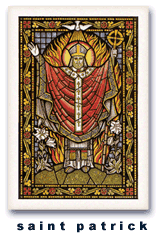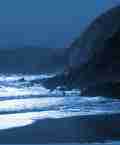 |
 | |||
 Much of Patrick's life is shrouded in mystery and historians differ on the probable chronology of the saint's life. Fortunately, he has left behind two documents, his Confession and his Letter to Coroticus,  which describe some of his experiences. He was not the first Christian missionary to reach Ireland, but the principal credit for converting the pagan island and establishing the Celtic church belongs to him. which describe some of his experiences. He was not the first Christian missionary to reach Ireland, but the principal credit for converting the pagan island and establishing the Celtic church belongs to him.He was the son of a Roman official, Calpurnius, living probably in Wales. As a boy of sixteen, Patrick was captured by raiders and sold to an Irish chieftain, Milchu. He spent years in slavery, herding sheep on Slemish Mountain in Co. Antrim. He escaped following a dream in which a voice told him a ship would be waiting to take him to his own country. After a journey of 200 miles he found the ship, and was eventually able to return to his family. One night, in a dream, he heard voices calling him back to Ireland. It is thought that he studied under Saint Germanus at Auxerre, France, and that his mission to Ireland was approved due to the early death of Saint Palladius, who had been sent as a bishop to the Irish "believing in Christ" in 431. Consequently, 432 is the traditional date for Patrick's voyage to Ireland, which ended on the shores of Strangford Lough. He quickly made a convert of a local chief named Dichu, who gave him a barn at Saul, Co. Down, for his first church. Before long Patrick made his way to the Hill of Tara, Co. Meath, seat of the high king of Ireland. Arriving on the eve of Easter, he lit a paschal fire on the nearby Hill of Slane. At this time of year, it was pagan practice to put out all fires before a new one was lit at Tara. When the druids at Tara saw the light from Slane, they warned King Laoghaire that he must extinguish it or it would burn forever. Patrick was summoned to Tara, and on the way he and his followers chanted the hymn known as "The Lorica" or "Saint Patrick's Breastplate". > > > Read the final part of this article From the Appletree Press title: A Little Book of Celtic Saints.
|
All Material © 1999-2005 Irelandseye.com and contributors
